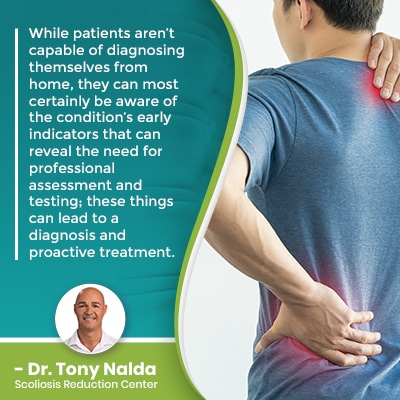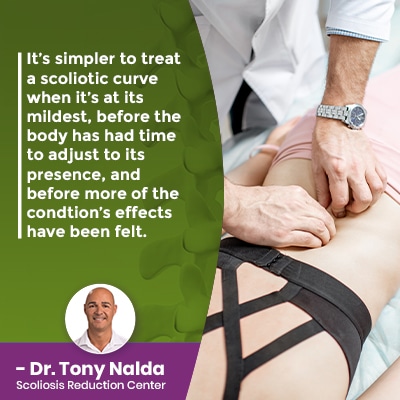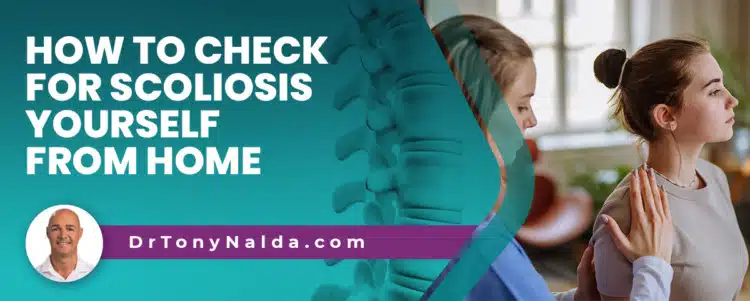While nothing replaces assessment and diagnosis from a medical professional, knowing the condition’s early signs and indicators can help lead to early detection. Although there are no treatment guarantees, early detection, when responded to with proactive treatment, can increase chances of treatment success; continue reading to find out how.
While no one can diagnose scoliosis from home as an X-ray and professional assessment are needed, a person can look for condition indicators. The earliest sign of scoliosis in adolescents is postural deviation, and for adults, the main scoliosis symptom is pain.
Let’s start with how a diagnosis of scoliosis is reached, for a better understanding of the difference between checking for condition indicators and what’s needed by a medical professional to officially diagnose scoliosis.
4 Key Takeaways
- Diagnosing Scoliosis: Professional assessment and diagnosis involving X-ray imaging and Cobb angle measurement are essential for confirming scoliosis. The condition’s 3-dimensional nature and minimum curve size criteria underscore the complexity of accurate diagnosis.
- Identifying Early Signs: Awareness of scoliosis’ early indicators, such as uneven shoulders or hips in adolescents and pain in adults, can lead to earlier detection and intervention, significantly enhancing treatment outcomes.
- Benefits of Early Detection: Early detection of scoliosis allows for proactive treatment before the condition progresses, making it easier to manage symptoms, prevent severe curvature, and maintain spinal flexibility.
- Treatment Approaches: A multifaceted treatment approach, integrating chiropractic care, physical therapy, corrective bracing, and custom exercises, offers the best strategy for managing scoliosis, emphasizing the importance of early and proactive treatment.
Diagnosing Scoliosis
There is no substitute for professional assessment and diagnosis, and this is because as a complex spinal condition, certain parameters have to be met in order to officially reach a diagnosis of scoliosis.
Scoliosis involves the development of an unnatural sideways spinal curve that also rotates, making it a 3-dimensional condition.
In addition, the unnatural curve has to be of a minimum size, and this can only be determined via X-ray.
A scoliosis X-ray involves looking at the spine from every angle for a true understanding of what’s happening in and around the spine, and also involves taking a number of complex measurements, the most important of which is known as Cobb angle.
In a healthy spine that has its natural curves in place, the vertebrae (bones of the spine) are aligned, but if the spine loses one or more of its healthy curves, some vertebrae have become tilted, causing the spine to become misaligned.
A scoliotic curve has to be of a minimum size to be diagnosed as scoliosis: a Cobb angle measurement of at least 10 degrees.
A patient’s Cobb angle measurement is needed for a diagnosis, and this is determined by drawing lines from the tops and bottoms of the curve’s most-tilted vertebrae, at its apex, and the intersecting lines form an angle that’s expressed in degrees.
The higher the Cobb angle, the more severe the condition:
- Mild scoliosis: Cobb angle measurement of between 10 and 25 degrees
- Moderate scoliosis: Cobb angle measurement of between 25 and 40 degrees
- Severe scoliosis: Cobb angle measurement of 40+ degrees
- Very-severe scoliosis: Cobb angle measurement of 80+ degrees
Cobb angle is a key piece of information needed to diagnose scoliosis, and effective treatment plans are shaped around it, so while a person can most certainly be aware of the condition’s early signs to watch for at home, a DIY approach to diagnosing scoliosis is not possible.
How to Check for Scoliosis Yourself
As mentioned, in order for scoliosis to be diagnosed, an unnatural sideways spinal curve, with rotation, and a minimum Cobb angle measurement of 10 degrees has to be present; these complexities necessitate the trained eye of a professional with access to an X-ray machine.
So what can a person check from home when it comes to scoliosis? This is a great question to ask because when I wrote Scoliosis Hope, it was with the goal of spreading awareness because early detection is very valuable.
While there are never treatment guarantees, early detection and intervention can increase the likelihood of treatment success.
Scoliosis is a progressive condition, meaning it has it in its nature to worsen over time, which is why catching the condition early on can be so beneficial.
As scoliosis progresses, the unnatural spinal curve is increasing in size, as are the uneven forces the condition is introducing to the body, and their effects.
So it’s these effects a person can check for at home as they can indicate the need for further testing.
Not only are there different severity levels of scoliosis, there are also different types, so for our current purposes, we’ll focus on the condition’s most-prevalent type: adolescent idiopathic scoliosis, diagnosed between the ages of 10 and 18.
Early Signs of Adolescent Idiopathic Scoliosis
Not only is adolescent idiopathic scoliosis the condition’s most-prevalent form, it is also a type that needs close monitoring as this age group is at risk for rapid-phase progression.
While the idiopathic designation means we don’t fully understand that condition’s onset, we do know how to treat it, and we do know what triggers its progression: growth and development.
Adolescents in, or entering into, the stage of puberty are going to have rapid and unpredictable growth spurts that can trigger fast progression, and it’s far simpler to proactively work towards preventing progression to minimize the condition’s effects, rather than trying to reverse them once they’ve occurred.
While screening for adolescent idiopathic scoliosis used to be mandatory and conducted by school nurses across the United States, that has since changed, shifting the onus of noticing the condition’s early signs onto the shoulders of patients/caregivers and adolescents themselves.

While patients aren’t capable of diagnosing themselves from home, they can most certainly be aware of the condition’s early indicators that can reveal the need for professional assessment and testing; these things can lead to a diagnosis and proactive treatment.
While each case is different, the common early signs of scoliosis in adolescents are related to postural deviation caused by the condition’s uneven forces and disruption to the body’s overall symmetry:
- Uneven shoulders
- Uneven shoulder blades
- The development of a rib arch
- Uneven hips
- Arms and legs that appear to hang at different lengths
In addition, changes to gait, balance, coordination, and clothing suddenly seeming ill-fitting are additional signs to watch for.
When it comes to scoliosis in adults, while postural deviation is part of the experience, the main symptom that brings adults in for a diagnosis and treatment is pain, and this is because scoliosis becomes compressive once skeletal maturity has been reached.
In children and adolescents who are still growing, the spine is experiencing a constant lengthening motion, and this counteracts the compressive force of the unnatural spinal curve: the main cause of condition-related pain.
While having a single body asymmetry doesn’t necessarily mean a person has scoliosis, noticing two or more of the above indicators does warrant the need for further testing, especially considering the benefits of early detection.
Why is Early Detection so Beneficial?
When scoliosis is diagnosed early in its progressive line, there are fewer limits to what can be achieved with treatment.
As scoliosis progresses, the spine becomes more rigid, making it less responsive to treatment, and as it’s also the spine’s surrounding muscles that maintain its natural curves and alignment, issues like muscle imbalance and strain are also less likely during the earlier stages of progression.

It’s simpler to treat a scoliotic curve when it’s at its mildest, before the body has had time to adjust to its presence, and before more of the condtion’s effects have been felt.
As a progressive condition, where a scoliosis is at the time of diagnosis is not indicative of where it will stay; only proactive treatment can work towards counteracting the condition’s progressive nature.
If scoliosis is diagnosed as mild, and particularly when treatment is started immediately, scoliosis is highly treatable; increasing condition severity can be prevented, a curvature reduction can be worked towards, and increasing core strength can help by ensuring the spine is optimally supported.
When treating adolescent idiopathic scoliosis, the goal is to reduce the curve on a structural level and to hold that reduction, despite the constant trigger of growth, so monitoring the spine closely to see how it’s responding to growth and treatment is key.
Here at the Scoliosis Reduction Center®, I integrate multiple condition-specific treatment disciplines to proactively impact conditions on every level: chiropractic care to work towards a curvature reduction, physical therapy and scoliosis-specific exercises to work towards increasing core muscle strength so the muscles surrounding the spine can optimally support it, corrective bracing to augment corrective results by pushing the spine into a corrective position, and rehabilitation to further stabilize the spine for long-term sustainable treatment results.
Conclusion
So for those wondering how to test yourself for scoliosis, there is no single test that can be performed at home capable of diagnosing scoliosis; however, I support people’s awareness of the condition’s early indicators as recognizing these early symptoms can lead to an official diagnosis and proactive treatment.
Diagnosing scoliosis involves professional assessment and X-ray imaging performed by a scoliosis specialist capable of taking a series of complex measurements so scoliosis can be further classified based on key patient/condition variables: patient age, condition type, curvature location, and condition severity (Cobb angle).
When it comes to the condition’s most-prevalent type, we’re talking about adolescent idiopathic scoliosis (AIS), and in many cases, the condition’s earliest telltale signs are uneven shoulders and hips.
In adults, for whom the condition is compressive, back pain and radiating pain, due to nerve involvement, is what brings most patients in for a diagnosis and treatment.
The best time to start scoliosis treatment is always now because as a progressive condition, even if a condition is mild when diagnosed doesn’t mean that’s where it will stay.




